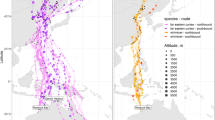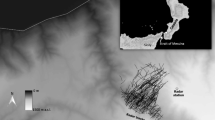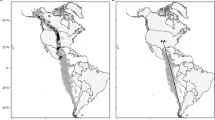Abstract
Migrating birds are expected to fly at higher airspeeds when minimizing time rather than energy costs of their migratory journeys. Spring migration has often been suggested to be more time selected than autumn migration, because of the advantage of early arrival at breeding sites. We have earlier demonstrated that nocturnal passerine migrants fly at higher airspeeds during spring compared to autumn, supporting time-selected spring migration. In this study, we test the hypothesis that seasonal airspeeds are modulated differently between short- and long-distance migrants, because of a stronger element of time selection for autumn migration over long distances. In support of this hypothesis, we demonstrate that the seasonal difference in airspeed is significantly larger (spring airspeed exceeding autumn airspeed by a factor of 1.16 after correcting for the influence of altitude, wind and climb/descent on airspeed) among short-distance compared to long-distance (factor 1.12) migrants. This result is based on a large sample of tracking radar data from 3 years at Falsterbo, South Sweden. Short-distance migrants also tend to fly with more favourable winds during autumn, indicating relaxed time constraints (being able to afford to wait for favourable winds) compared to long-distance migrants. These results indicate surprisingly fine-tuned seasonal modulation of airspeed and responses to wind, associated with behavioural strategies adapted to different levels of time selection pressures during spring and autumn migration.




Similar content being viewed by others
References
Alerstam T (1979) Wind as selective agent in bird migration. Ornis Scand 10:76–93
Alerstam T (1991) Bird flight and optimal migration. Trends Ecol Evol 6:210–215
Alerstam T (2003) Bird migration speed. In: Berthold P, Gwinner E, Sonnenschein E (eds) Avian migration. Springer, Berlin, pp 253–267
Alerstam T (2006) Strategies for the transition to breeding in time-selected bird migration. Ardea 94:347–357
Alerstam T, Lindström Å (1990) Optimal bird migration: the relative importance of time, energy and safety. In: Gwinner E (ed) Bird migration: physiology and ecophysiology. Springer, Berlin, pp 331–351
Bäckman J, Alerstam T (2003) Orientation scatter of free-flying nocturnal passerine migrants: components and causes. Anim Behav 65:987–996
Bruderer B, Peter D, Boldt A, Liechti F (2010) Wing-beat characteristics of birds recorded with tracking radar and cine camera. Ibis 152:272–291
Conklin JR, Battley PF, Potter MA (2013) Absolute consistency: individual versus population variation in annual-cycle schedules of a long-distance migrant bird. PLoS ONE 8:e54535
Falsterbo Bird Observatory (2013) http://www.falsterbofagelstation.se. Accessed 12 August 2013
Hedenström A, Alerstam (1995) Optimal flight speed of birds. Philos T Roy Soc B 348:471–487
Hedenström A, Alerstam T (1997) Optimum fuel loads in migratory birds: distinguishing between time and energy minimization. J Theor Biol 189:227–234
Henningsson P, Karlsson H, Bäckman J, Alerstam T, Hedenström A (2009) Flight speeds of swifts (Apus apus): seasonal differences smaller than expected. Proc R Soc Lond B 276:2395–2401
Houston AI (2000) The strength of selection in the context of migration speed. Proc R Soc Lond B 267:2393–2395
Karlsson L (2009) Vingar över Falsterbo, 2nd ed. 192. Falsterbo fågelstation, Falsterbo
Karlsson H, Nilsson C, Bäckman J, Alerstam T (2011) Nocturnal passerine migration without tailwind assistance. Ibis 153:485–493
Karlsson H, Nilsson C, Bäckman J, Alerstam T (2012) Nocturnal passerine migrants fly faster in spring than in autumn: a test of the time minimization hypothesis. Anim Behav 83:87–93
Kokko H (1999) Competition for early arrival in migratory birds. J Anim Ecol 68:940–950
La Sorte FA, Fink D, Hochachka W (2013) Population-level scaling of avian migration speed with body size and migration distance for powered fliers. Ecology 94:1839–1847
McNamara JM, Welham RK, Houston AI (1998) The timing of migration within the context of an annual routine. Oikos 29:416–423
Newton I (2008) The migration ecology of birds. Academic Press/Elsevier, London
Nilsson C, Klaassen RHG, Alerstam T (2013) Differences in speed and duration of bird migration between spring and autumn. Am Nat 181:837–845
Pennycuick CJ (2008) Modelling the flying bird. Academic, Amsterdam
Quinn GP, Keough MJ (2002) Experimental design and data analysis for biologists. Cambridge University Press, New York, pp 364–365
Roos G (1984) Migration, wintering and longevity of birds ringed at Falsterbo (1947–1980). Anser Suppl 13:1–208
Rudebeck G (1950) Studies in bird migration. Vår Fågelvärd, Berlingska Boktryckeriet, Lund, Sweden, Suppl 1:1–148
Schmaljohann H, Liechti F (2009) Adjustments of wingbeat frequency and air speed to air density in free-flying migratory birds. J Exp Biol 212:3633–3642
Schmaljohann H, Fox JW, Bairlein F (2012) Phenotypic response to environmental cues, orientation and migration costs in songbirds flying halfway around the world. Anim Behav 84:623–640
Seewagen CL, Guglielmo CG, Morbey YE (2013) Stopover refueling rate underlies protandry and seasonal variation in migration timing of songbirds. Behav Ecol 24:634–642
Swedish metrological and hydrological institute (2013) http://www.smhi.se/klimatdata/meteorologi/dataserier-2.1102. Accessed 4 June 2013
van Noordwijk AJ, McCleery RH, Perrins CM (1995) Selection for the timing of great tit breeding in relation to caterpillar growth and temperature. J Anim Ecol 64:451–458
Weast RC (ed) (1964) Handbook of chemistry and physics. The Chemical Rubber Co., Ohio
Acknowledgments
We are very grateful for the important support and information (capture and weather data) from the Falsterbo Bird Observatory. We want to thank Heiko Schmaljohann and an anonymous reviewer for constructive comments as well as Lars Råberg for statistical advice. This work was funded by the Swedish Research Council (grants to TA), and the authors are associated with the Centre for Animal Movement Research at Lund University. This is report number 283 from the Falsterbo Bird Observatory.
Author information
Authors and Affiliations
Corresponding author
Additional information
Communicated by W. Wiltschko
Electronic supplementary material
Below is the link to the electronic supplementary material.
ESM 1
(PDF 894 kb)
Rights and permissions
About this article
Cite this article
Nilsson, C., Bäckman, J. & Alerstam, T. Seasonal modulation of flight speed among nocturnal passerine migrants: differences between short- and long-distance migrants. Behav Ecol Sociobiol 68, 1799–1807 (2014). https://doi.org/10.1007/s00265-014-1789-5
Received:
Revised:
Accepted:
Published:
Issue Date:
DOI: https://doi.org/10.1007/s00265-014-1789-5




